Uk Environment Agency
-
- Recycling of Ships Maritime Reporter, Jan 2004 #18
As of July 1, 2003, there were approximately 29,000 commercial self-propelled ocean-going ships worldwide in excess of 1.000 gross tons each. Of these, just over 400 are U.S. Hag. In addition, there are approximately 3,000 U.S. barges of over 1,000 gross tons each. Approximately 25% of these ships and barges are more than 20 years old and will be taken out of service in the near future. The vast majority of the ships and barges taken out of service will be recycled (scrapped). Exactly when a ship is taken out of service is dependent upon a variety of factors, the most important being its maintenance costs and its current charter rate. Thus, the number of ships being offered for recycling can and does gyrate widely over time.
There is growing realization that ships (and, to a lesser extent, barges) frequently contain hazardous materials. These materials may become hazardous wastes when a ship or barge is to be recycled.
Ship recycling in the United States and many other countries in the developed world is subject to environment controls.
Such recycling in lesser developed nations is not currently regulated to the same extent.
Many nations are party to the Basel Convention on the Control of Transboundary Movements of Hazardous Wastes and their Disposal.
This Convention is intended to prevent hazardous wastes from being transported to another country for disposal unless the receiving country has provided knowing consent to such action. Ships being transferred from one party state for recycling in another party state appear to come within the Convention, although there is some uncertainty in this regard.
While the United States is not party to the Basel Convention, it has adopted domestic legislation having the same impact. The Resource Conservation and Recovery Act (RCRA) provides, in pertinent part, that hazardous waste may not be exported from the United States unless various conditions are met. The person who intends to export the hazardous waste must provide written notification to the Environmental Protection Agency (EPA). The notification must contain the name and address of the exporter, the types and quantities of hazardous waste to be exported, the date of the planned exportation, the port of entry at destination, the method of transport.
the name and address of the ultimate disposal facility, and the names of any transit countries through which the hazardous waste will be sent.
The United States is party to several international agreements concerning international trade in hazardous waste.
The primary agreement is among member countries of the Organization for Economic Cooperation and Development (OECD). These agreements share the basic principles of notification by the exporter to the government of the exporting country, government- to-government notification to the receiving country, and receiving country consent to the shipment.
More broadly, the International Maritime Organization (IMO) is developing guidelines on ship recycling that may lead to mandatory requirements for an inventory of hazardous material on the ship. This inventory would be initiated during construction and continue to be maintained until the ship is recycled.
At the same time, the International Labor Organization (ILO) is developing guidelines for ship-breaking. These standards would address working and environmental conditions at locations where ships are to be recycled.
The EPA has specifically examined the ship scrapping and recycling industry.
The agency has identified a variety of hazardous wastes commonly associated with ships being scrapped or recycled.
These hazardous wastes include polychlorinated biphenyls (PCBs). asbestos, heavy metals, pesticides, and waste oils.
These hazardous wastes must either be removed from the ship prior to export or the consent of both the EPA and the receiving country must be obtained before a ship can be exported from the United States for recycling in a foreign country. The International Chamber of Shipping (ICS), in conjunction with other maritime organizations, developed the "Industry Code of Practice on Ship Recycling." This Code provides that, when a ship is to be sold for recycling, the owner will inventory the potentially hazardous materials on board and take steps to minimize those materials before the ship is delivered for recycling. The Code also contains a list of potentially hazardous and toxic materials frequently found on ships.
The EPA restrictions on export of ships for recycling have been applied to government ships. The Maritime Administration (MARAD) encountered various obstacles and added expense in disposing of obsolete vessels from the National Defense Reserve Fleet (NDRF). After MARAD awarded a contract for the recycling of 15 NDRF ships at a facility in the United Kingdom, suit was brought by several environmental advocacy groups to block the exportation. The complaint alleged a number of violations of law, including the failure to conduct an environmental assessment and the failure to obtain an exemption from the EPA for the export of PCB for disposal.
The trial court allowed the export of four obsolete MARAD ships as a Congressionally-approved pilot program, but has granted a temporary restraining order against export of any further vessels. The major finding of the court in prohibiting further vessel exports is the apparent violation of the ban on export of PCB without an EPA exemption. Subsequently, the UK Environment Agency withdrew approval for the ships to be recycled, noting that the contractor had not obtained permission to expand its facility to perform such work. The four NDRF ships may be returned to the United States in the spring, unless the matter can be sorted out.
As important as the litigation surrounding the export for recycling of the obsolete MARAD vessels is the contract that MARAD awarded for this disposal.
Whereas the traditional arrangement for recycling of ships involves the sale of the ship for its so-called scrap value, the MARAD arrangement provided for MARAD to pay the contractor $14.8 million for removal and recycling of 15 ships. The high visibility of these exports and the government status of the ships were, no doubt, major factors in this unique arrangement. This payment for recycling of ships, though, alters the traditional view that ships always retain a certain minimal value (the value of the steel and related material in the hull).
The French Government is involved in a similar controversy regarding efforts to recycle the retired aircraft carrier Clemenceau. The ship apparently contains over 200 tons of asbestos. Efforts to have the ship recycled in Turkey met with protests and the ship has been returned to France for removal of the asbestos and any other hazardous waste.
Lest anyone think this problem is exclusive to government vessels, your attention is invited to the chemical tanker Sandrien. This ship, suspected of having onboard asbestos and various hazardous chemicals, has been tied up the Netherlands since 2001. The owners have been unable to obtain clearance from the Dutch government to send the ship for recycling in India because the government is requiring full compliance with the Basel Convention.
Due in large part to heightened environmental concerns and new apprehensions about the safety and health of employees of ship recyclers, we may be approaching the day when owners of both government vessels and regular commercial ships will regularly pay to have their ships recycled.
Minimalization and monitoring of hazardous materials on ships is highly recommended.
-
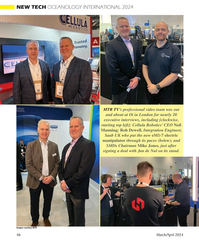 )
March 2024 - Marine Technology Reporter page: 46
)
March 2024 - Marine Technology Reporter page: 46for nearly 20 executive interviews, including [clockwise, starting top left]: Cellula Robotics’ CEO Neil Manning; Rob Dewell, Integration Engineer, Saab UK who put the new eM1-7 electric manipulator through its paces (below); and SMDs Chairman Mike Jones, just after signing a deal with Jan de Nul on its
-
 )
March 2024 - Marine Technology Reporter page: 45
)
March 2024 - Marine Technology Reporter page: 45Valeport Teledyne Marine agreed to acquire Valeport a leader in the design and manufacture of underwater sensors and pro? l- ers. Valeport is one of the UK’s leading manufacturers of oceanographic and hydrographic instrumentation. The in- dependent family-owned business, which was established in 1969
-
 )
March 2024 - Marine Technology Reporter page: 39
)
March 2024 - Marine Technology Reporter page: 39Photo courtesy Global Ocean Design Figure 7 A 35Ah AGM lead-acid battery is tested using the West Mountain Radio CBA to show the effect of simply ? lling the battery voids with mineral oil as a compensating ? uid. The CBA is programmed to cut-off at a voltage of 10.50v. The top line (red) shows the
-
 )
March 2024 - Marine Technology Reporter page: 32
)
March 2024 - Marine Technology Reporter page: 32plastic tracks and buoyant syntactic foam. The collec- tion plan on nodules by March 2024. tion vehicle uses sonar to identify the position of the nodules UK-based Soil Machine Dynamics (SMD) designed, devel- and has attained collection ef? ciency rates of at least 97% in oped and delivered the mining machinery
-
 )
March 2024 - Marine Technology Reporter page: 25
)
March 2024 - Marine Technology Reporter page: 25to survey the aftermath of subsea volca- nic activity. Controlled remotely from the company’s base 16,000 km away in the Portable System Requires only UK, Maxlimer mapped the shape of the Wavelet 2KW at 250ms Ping Rate CorrelaO on > 0.96 caldera and measured the environmental conditions of water above
-
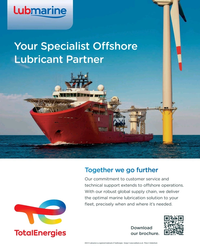 )
April 2024 - Maritime Reporter and Engineering News page: 3rd Cover
)
April 2024 - Maritime Reporter and Engineering News page: 3rd Cover?eet, precisely when and where it’s needed. Download our brochure. 2024 ® Lubmarine is a registered trademark of TotalEnergies - Design © www.matblack.co.uk - Photo © AdobeStock COV2, C3 &C4 MR Apr 2024.indd 2 4/5/2024 2:35:19 P
-
 )
April 2024 - Maritime Reporter and Engineering News page: 48
)
April 2024 - Maritime Reporter and Engineering News page: 48Systems Ltd, Clittaford Road Southway, Massa Products Corporation, 280 Lincoln Street, UNDERWATER SONAR SENSORS Plymouth, Devon PL6 6DE United Kingdom , UK , Hingham, MA 02043-1796 , tel:(781) 749-4800, tel:+44 (0) 1752 723330, [email protected] [email protected] contact: Nick Landis Massa Products
-
 )
April 2024 - Maritime Reporter and Engineering News page: 41
)
April 2024 - Maritime Reporter and Engineering News page: 41Nautel provides innovative, industry-leading solutions speci? cally designed for use in harsh maritime environments: • GMDSS/NAVTEX/NAVDAT coastal surveillance and transmission systems • Offshore NDB non-directional radio beacon systems for oil platform, support vessel & wind farm applications
-
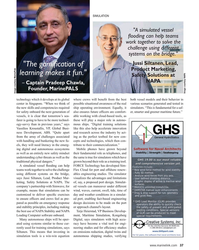 )
April 2024 - Maritime Reporter and Engineering News page: 37
)
April 2024 - Maritime Reporter and Engineering News page: 37SIMULATION "A simulated vessel ? ooding can help teams work together to solve the challenge using different systems on the bridge." – Jussi Siltanen, Lead, "The gami? cation of Product Marketing, learning makes it fun." Safety Solutions at NAPA – Captain Pradeep Chawla, Founder, MarinePALS Image
-
 )
April 2024 - Maritime Reporter and Engineering News page: 35
)
April 2024 - Maritime Reporter and Engineering News page: 35SIMULATION e have a close relationship with tech- Realism is prized beyond immersive, photo-realistic visu- nology, evidenced by, for example, als, and providers are introducing increasingly accurate func- the phones we are estimated to un- tionality. FORCE Technology’s upcoming DEN-Mark2 math- lock around
-
 )
April 2024 - Maritime Reporter and Engineering News page: 28
)
April 2024 - Maritime Reporter and Engineering News page: 28FEATURE INTERVIEW track missiles and warheads for the Mis- sile Defense Agency, and it travels with its support ship, the MV Hercules. For our Service Support ships, we have the two hospital ships, USNS Mer- cy and Comfort; two rescue and salvage ships; two submarine tenders; and the Sixth Fleet ?
-
 )
April 2024 - Maritime Reporter and Engineering News page: 27
)
April 2024 - Maritime Reporter and Engineering News page: 27RADM PHILIP SOBECK, MILITARY SEALIFT COMMAND With COVID, we had to make some hard choices for our Do your CIVMARs have upward mobility? mariners because we couldn’t rotate. Many of our mariners The Navy has Sailors who become “Mustangs,” and work found other employment, and were able to use their skills
-
 )
April 2024 - Maritime Reporter and Engineering News page: 25
)
April 2024 - Maritime Reporter and Engineering News page: 25RADM PHILIP SOBECK, MILITARY SEALIFT COMMAND Photo by Brian Suriani USN Military Sealift Command From a global supply chain perspective, What makes MSC so vital to the we’ve learned a lot about dealing with Navy’s ? eet and our military disruptions. COVID delivered a big forces around the world? wake-up
-
 )
April 2024 - Maritime Reporter and Engineering News page: 21
)
April 2024 - Maritime Reporter and Engineering News page: 21and evolving our services across all for more than three decades, ‘cutting his teeth’ offshore infrastructure along with our continued support to the in a UK design ? rm working in the North Sea marine industry,” said Langford. “We continue to hire key in- oil and gas platforms, the holy grail of rigorous
-
 )
April 2024 - Maritime Reporter and Engineering News page: 14
)
April 2024 - Maritime Reporter and Engineering News page: 14Book Review Approach to Meeting Underwater Radiated Noise Limits Def ned By Raymond Fischer uantitative underwater radiated noise limits will construction inspections, 5) possible training with respect to be developed shortly by IMO, and/or countries salient design/construction essentials, 6) compliance
-
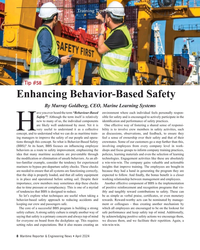 )
April 2024 - Maritime Reporter and Engineering News page: 8
)
April 2024 - Maritime Reporter and Engineering News page: 8Training Tips for Ships © By tuastockphoto/AdobeStock Tip #58 Enhancing Behavior-Based Safety By Murray Goldberg, CEO, Marine Learning Systems ave you ever heard the term “Behaviour-Based environment where each individual feels personally respon- Safety”? Although the term itself is relatively sible for
-
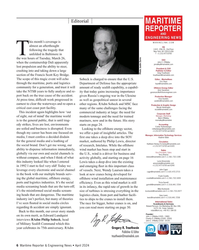 )
April 2024 - Maritime Reporter and Engineering News page: 6
)
April 2024 - Maritime Reporter and Engineering News page: 6ity that today gains increasing importance [email protected] port back on the true cause of the accident. given Russia’s ongoing war in the Ukraine Production Manager Irina Vasilets At press time, dif? cult work progressed in as well as geopolitical unrest in several vasilets@marinelink
-
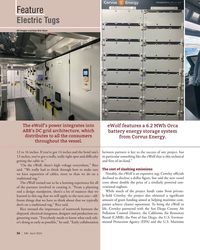 )
April 2024 - Marine News page: 34
)
April 2024 - Marine News page: 34Feature Electric Tugs All images courtesy Eric Haun The eWolf’s power integrates into eWolf features a 6.2 MWh Orca ABB’s DC grid architecture, which battery energy storage system distributes to all the consumers from Corvus Energy. throughout the vessel. 12 to 16 inches. If you’ve got 14 inches and
-
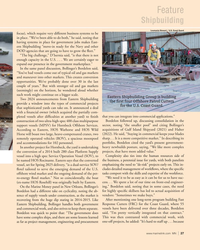 )
April 2024 - Marine News page: 27
)
April 2024 - Marine News page: 27Feature Shipbuilding Loumania Stewart / U.S. Coast Guard focus), which require very different business systems to be in place. “We’ve been able to do both,” he said, noting that having systems in place for government jobs makes East- ern Shipbuilding “move-in ready for the Navy and other DOD agencies
-
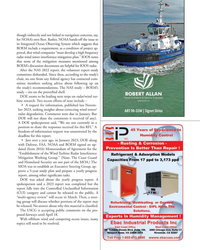 )
April 2024 - Marine News page: 25
)
April 2024 - Marine News page: 25though indirectly and not linked to navigation concerns, say, for NOAA’s own ? eet. Rather, NOAA hands-off the issue to its Integrated Ocean Observing System which suggests that BOEM include a requirement, as a condition of project ap- proval, that wind companies “must develop a high frequency radar
-
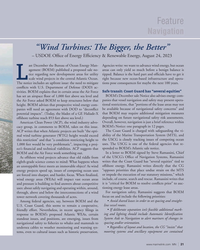 )
April 2024 - Marine News page: 21
)
April 2024 - Marine News page: 21Feature Navigation “Wind Turbines: The Bigger, the Better” – USDOE Of? ce of Energy Ef? ciency & Renewable Energy, August 24, 2023 ast December the Bureau of Ocean Energy Man- Agencies write: we want to advance wind energy, but ocean agement (BOEM) published a proposed sale no- areas can only yield so
-
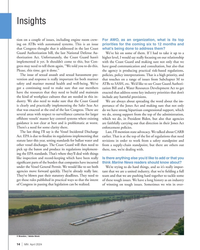 )
April 2024 - Marine News page: 14
)
April 2024 - Marine News page: 14Insights tion on a couple of issues, including engine room crew- For AWO, as an organization, what is its top ing on ATBs with automated systems. This is an issue priorities for the coming six to 12 months and that Congress thought that it addressed in the last Coast what’s being done to address them? Gua
-
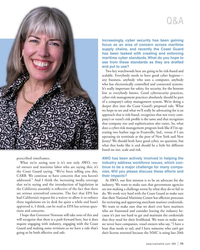 )
April 2024 - Marine News page: 11
)
April 2024 - Marine News page: 11Q&A Increasingly, cyber security has been gaining focus as an area of concern across maritime supply chains, and recently the Coast Guard has been tasked with creating and enforcing maritime cyber standards. What do you hope to see from these standards as they are drafted and put to use? Two key
-
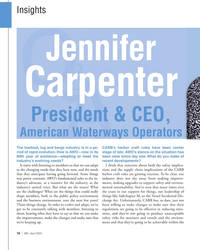 )
April 2024 - Marine News page: 10
)
April 2024 - Marine News page: 10Insights Jennifer QQQQQQQQQAAA & Carpenter President & CEO, American Waterways Operators The towboat, tug and barge industry is in a pe- CARB’s harbor craft rules have been center riod of rapid evolution. How is AWO—now in its stage of late. AWO’s stance on the situation has 80th year of existence—adapt
